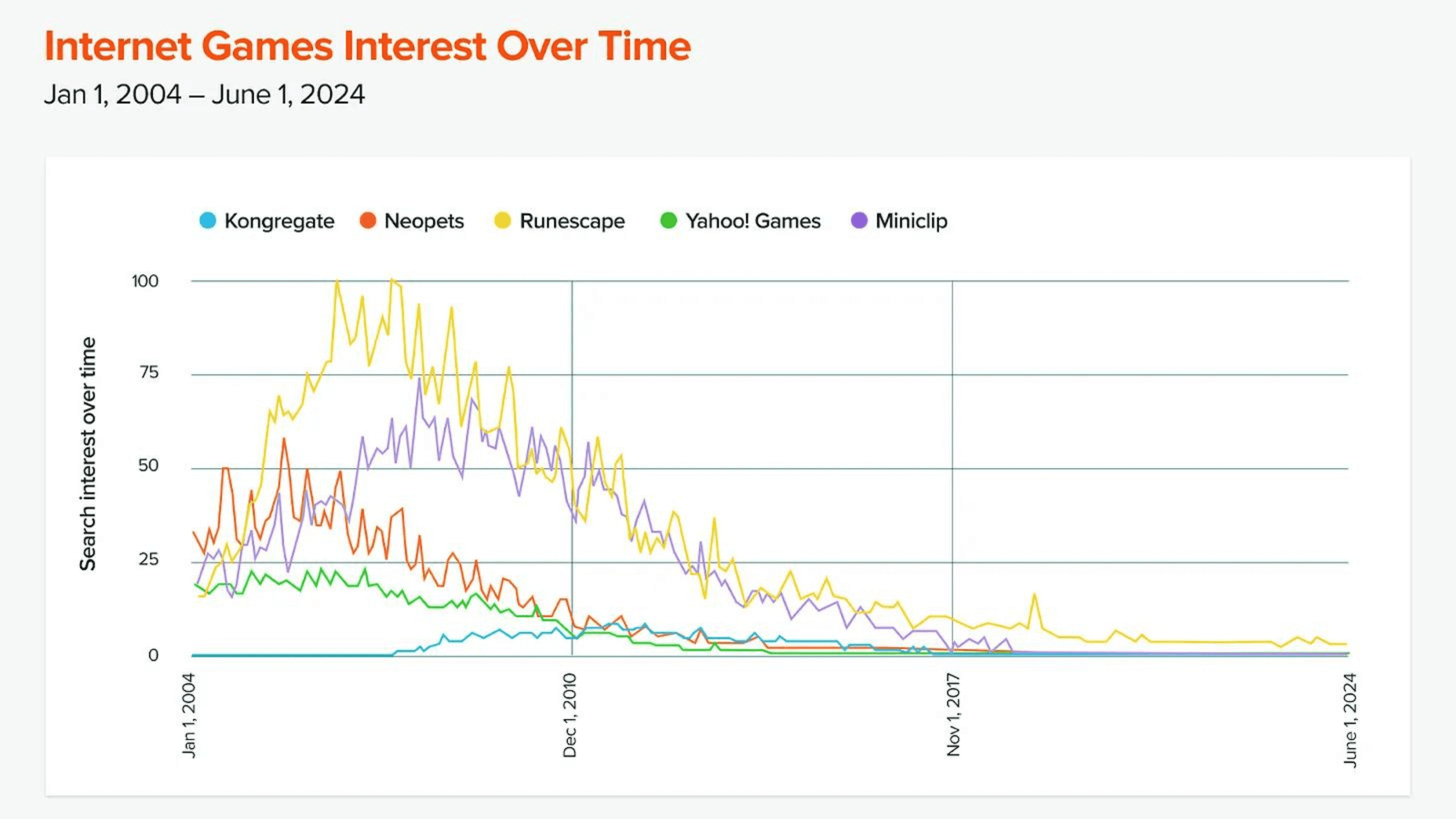In the early 2000s, web gaming enjoyed its heyday, capturing the attention of millions of players worldwide. Platforms like Miniclip and Kongregate hosted billions of games each month, attracting a broad audience with accessible, browser-based experiences. However, by the 2010s, web gaming began to lose momentum, largely due to the rise of mobile gaming and the discontinuation of Adobe Flash.
Despite this decline, industry experts believe that web gaming is poised for a comeback, driven by advancements in technology and new distribution models. In this article, we will summarize a recent blog post from a16z and add insights into why these findings are particularly relevant in the world of web3 gaming.

a16z Games Logo
Rise and Fall of Web Games
The early success of web gaming can be traced back to platforms like Miniclip, which launched in 2001 and quickly gained traction with viral hits like Dancing Bush. Miniclip founders Rob Small and Tihan Presbie democratized gaming by making their titles freely available over the internet. Their decision to allow users to embed Miniclip games on other websites gave the platform a significant SEO boost, securing its dominance in the online gaming space.
However, as mobile gaming exploded and Adobe Flash was phased out, web-based games struggled to maintain their audience. By 2010, players were migrating to mobile platforms, where app stores provided easy access to games optimized for touchscreens and mobile hardware. Even Miniclip, once synonymous with web gaming, pivoted to mobile and achieved success with titles like Subway Surfers.

Internet Games Interest Over Time
The Three Audiences of Web Games
Emily Greer, co-founder of Kongregate, offers insight into why web gaming initially thrived and what caused its decline. Greer commented: “Ad revenue grew steadily with our traffic, but by the peak, 80% of revenue came from IAP. I’ve never talked about total amounts, but we had a lot of games where average revenue per paying user was $200 or $300.”
Greer identifies three key audiences for web games:
- Deep Casual Players: These players engage with games regularly but do not necessarily identify as gamers. They were drawn to the accessibility of browser-based puzzle and card games, and many eventually transitioned to mobile titles like Candy Crush.
- Hypercasual Gamers: Known for playing simple, viral games with basic mechanics, this audience moved from web games to mobile as mobile marketing took off. However, recent shifts in mobile advertising trends may push this group back to web-based platforms.
- Access-Disadvantaged Players: Gamers from regions with limited access to high-end hardware or who played at school due to restrictions found browser games to be an ideal solution. As mobile devices became more widely available, even this audience gravitated toward mobile gaming for its convenience.
Greer believes that while web games are no longer dominant, their ability to meet specific needs—especially for players with limited access—suggests there is still a place for them in the gaming ecosystem. Greer commented: “Mobile became dominant because it was a more convenient device. And then the PC is the most powerful and beautiful and performant. So when the web is winning, it's because it's meeting some access needs and filling in some niche that those two things aren’t doing—it's coming in between.”

Emily Greer Co-Founder of Kongregate
The New Wave of Web Games
A new generation of web gaming startups is emerging, fueled by advances in technology and changes in how players access games. Companies like Echo Chunk AI, Lil Snack, and 2weeks Corp are part of a growing movement to redefine web gaming, utilizing modern web technologies to deliver more sophisticated and accessible experiences.
Sami Ramly, founder of Echo Chunk AI (making Echo Chess), points out that web games are no longer confined to browsers. They can now be integrated into apps, and messaging platforms like Discord and Telegram, or distributed via simple web links, reducing the friction of app installs. Travis Chen of Lil Snack echoes this sentiment, noting that players can start a web game in seconds without needing to visit an app store or download a separate application.
Ramly commented: “I think this maybe was a solid argument 5-10 years ago because having an app you love right there on your home screen was a great reminder of a daily habit you're forming. But these days most people have so much app fatigue and so many apps on their phones that grooming your home screen is a chore in itself. You even have to search for the app you're thinking of!”

Sami Ramly Founder of Echo Chunk AI (Making Echo Chess)
Advancements in Web Technology
A major factor in the potential resurgence of web gaming is the development of new tools and technologies that rival those used in traditional gaming platforms. HTML5 and game engines like Unity and PlayCanvas have evolved to support more complex and high-performing games. The advent of WebGL and WebAssembly has narrowed the gap between web-based games and their console or PC counterparts.
Brandon Dillon, CEO of 2weeks Corp, highlights how these advancements are closing the performance gap that once held web games back. WebGL 2.0 and the upcoming WebGPU offer graphics capabilities comparable to those found on gaming consoles like the Nintendo Switch. While web games may still face limitations—such as hardware constraints and the inability to support AAA games—developers now have the tools to create engaging, high-performance experiences that can run on a wide range of devices.
Dillon commented: “Historically, web tech didn't have the performance or responsiveness needed to build games that were competitive with traditional gaming platforms. This was true even in the height of the Flash era, the last big wave of web games—you could build some pretty credible 2D games in Flash, and there was a ton of fun and innovative stuff getting made, but no one would mistake them for PC and console games of the era.”

HTML5 vs Unity
Challenges and Opportunities
Despite the promise of new technologies, web gaming still faces challenges. The inability to rely on large initial downloads and the need to support various devices can limit the scope of what developers can achieve. However, these limitations may also present an opportunity. The inherent constraints of web gaming encourage developers to create accessible, fast-loading games that can reach a broad audience, making them ideal for viral growth.
As mobile app fatigue sets in, the convenience and instant access offered by web games could once again become a significant draw for players. Whether through browser-based experiences or integration into other platforms, web gaming is on the verge of a resurgence, offering both new and nostalgic players a fresh way to engage with their favorite titles.
Dillon commented: “The constraints of the web encourage you to build experiences that can run on a wide range of hardware and that players can get into instantly. These are exactly the things you want to optimize for if you want an experience that's primed for discovery and growth.”

Old Web Games
Relevance to Blockchain Gaming
The resurgence of web gaming is particularly relevant to the evolving landscape of blockchain, or web3 gaming, as both share a focus on decentralized, accessible gaming experiences. Web3 gaming leverages blockchain technology to offer ownership, interoperability, and monetization opportunities, much like early web games democratized access to gaming through browsers.
As advancements in web technologies such as HTML5 and WebGL make more complex, high-performance games possible, web3 games can capitalize on these improvements to create seamless, browser-based experiences that align with blockchain's emphasis on open, decentralized platforms.
This new era of web gaming could provide an ideal foundation for the growth of web3 gaming ecosystems. While the golden era of web gaming may seem like a distant memory, the rise of new technologies and distribution models suggests that a renaissance could be on the horizon.
Source: a16z



